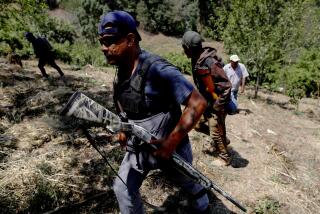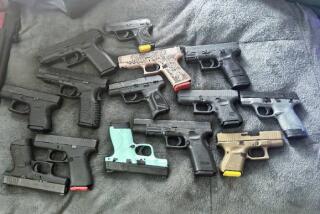Lenient U.S. Gun Laws Spur Illegal Exports
MCALLEN, Tex. — James Diaz went out one day and bought a couple of guns. Then he bought some more.
As the months went by, the numbers climbed. Thirty. Forty. Then past 100. The Bureau of Alcohol, Tobacco and Firearms took note of Diaz when the number reached 168 guns purchased in a little more than a year.
When Diaz was confronted by ATF agents, he could not account for a single weapon. Dan Carpenter, the acting ATF supervisor in this small Texas border city, said there is no question as to where the guns went: to Mexico, where they would fetch at least double, perhaps five times the price paid in the United States. And business these days is booming.
“Things have really picked up in the last year or so,” Carpenter said.
Diaz pleaded guilty to conspiracy to deal in firearms and is serving a year in prison, but he is only a bit player in the world of gun smuggling. Each year, thousands of firearms worth millions of dollars are spirited out of this country to Mexico, Colombia, Peru, the Caribbean, the Far East, Europe and other destinations around the world.
It is legal and easy to buy a gun in the United States, and it is legal to buy large quantities of weapons for personal use.
However, there are laws governing the exporting of weapons. For example, it is illegal to send automatic weapons or silencers out of the United States. Legitimate exporters must be licensed by the U.S. State Department.
The export laws are enforced, in large measure, by the Bureau of Alcohol, Tobacco and Firearms and the Customs Service. But those agencies have no more than a guess as to just how many weapons are exported.
Part of the reason is the enormous, unregulated supply of arms. There are, by a federal estimate, at least 140 million guns in the United States, and roughly 4 million more are produced each year. There are more than 270,000 federally licensed gun dealers in the United States.
“It’s a very difficult thing to try to quantify,” said Don DeFago, chief of the munitions branch in the Customs Service’s Strategic Investigations Division. “That’s one of our problems. We don’t know what the universe is. We can’t judge the scope of the problem.”
Except that it is growing larger.
In Mexico, where guns were banned after the blood-bath civil war early in this century, the ever-increasing number of smuggled weapons has raised a siren of alarm.
Luis Soto Silva, director of narcotics investigations for Mexico’s attorney general, said the presence of so many guns represents a great danger to his own personnel as well as to the public. There is a direct effect, he said, when drug dealers have huge caches of weapons, including assault rifles and grenades.
“The fact that these groups of people have arms available to them makes the entire society more violent,” he said.
The numbers speak for themselves. From Dec. 1, 1988, until Oct. 31, 1990, 64 of Mexico’s narcotics policemen were killed in the line of duty; 68 have been killed in the last five months.
In 1989, Colombian President Virgilio Barco Vargas asked for two things: that the United States push to reduce demand for drugs inside its borders and that the federal government find a way to cut off the flow of semiautomatic weapons to the Colombian drug cartels.
Earlier this year, the ATF delivered to the House Foreign Affairs Committee a 244-page report on arms trafficking, calling it a “jigsaw puzzle with many of the pieces missing.”
“As the world shrinks, the problems of one country become the problems of other countries,” the report said. “Cocaine flows into the United States and guns flow out, but the guns do not disappear.
They are used in political assassinations in Colombia, they are used by terrorists in Peru, or they return to the United States guarding drug shipments.”
Although there are no hard numbers about guns smuggled out of the country, there is a great deal of anecdotal evidence about the scope of the problem.
In the small town of Temple, Tex., Milton Massengale sold nearly 2,000 weapons over a 10-year period to a Mexican man who smuggled them across the border. Massengale pleaded guilty last year to possession of unregistered firearms and conspiracy to violate the Neutrality Act.
“There is just so much money to be made with these weapons.” said Larry Sparks, of the ATF’s Austin, Tex., office, which handled the case.
Last year, three men suspected of being members of the Irish Republican Army were found guilty of trying to buy a Stinger missile from federal agents who posed as arms dealers.
In 1989, customs agents at Los Angeles International Airport seized 463 weapons that were headed for Mexico. Last year, 600 guns were confiscated.
The methods of concealing the weapons are sometimes ingenious. In one incident several years ago at the airport, customs officers intercepted assault rifles, hand grenades, bullets, night-vision goggles and other equipment packed inside toy stuffed animals and in an air conditioner.
The number of guns being smuggled into the Philippines from the United States is on the rise, largely because of the unstable political situation there. Federal officials believe the Philippines has become a staging area for the distribution of guns throughout the Far East, principally to crime syndicates in Japan, called Yakuza or Boryokudan .
DeFago of the Customs Service said that the Philippines, with its political unrest, guerrilla groups and a citizenry feeling the need for more protection, is a perfect mark for smugglers. “It’s got all the things you need for an expanding market,” he said.
According to the ATF report, a Smith & Wesson .38-caliber revolver that sells for $250 in the United States can fetch $1,250 on the black market in the Philippines. It is not uncommon, according to the ATF report, for a Philippines citizen to purchase a couple of handguns in the United States, then sell them back home as a way of paying for the trip.
In September, 1989, Philippine Congressman Nicanor de Guzman flew home from Los Angeles with 314 handguns tucked away in his luggage, as well as spare parts and ammunition.
After the leaders of an attempted Trinidad coup surrendered last year, federal authorities traced the 135 weapons used in the revolt. ATF officials said that 105 of them were purchased at gun shows or shops in South Florida.
“We provide a lot of guns to the rest of the world, and these are going into the underground economy,” said Stephen E. Higgins, director of the ATF. “It’s not just for narcotics. It’s for other things as well, including self-protection.”
One of the reasons gun smuggling is so common in the United States is that it is so easy to purchase a firearm.
“It’s no secret the gun laws in the United States make it much easier to own guns here than in other places in the world,” Higgins said.
Susan Whitmore of Handgun Control Inc. was a bit harsher in her assessment of the effects of gun smuggling, particularly by the drug barons of Latin America.
“It’s just too easy,” she said. “We say we’re fighting the drug war, but we’re arming the enemy.”
Whitmore’s organization has been one of the principal proponents of the so-called Brady Bill, federal legislation that would require a seven-day waiting period so that a would-be gun buyer’s criminal record could be checked. The House passed the bill by a larger-than-expected margin earlier this month, but President Bush has threatened to veto it unless it is part of a broader anti-crime package.
“No one is making the claim that the Brady Bill is a panacea, but at least we should put a roadblock in their path,” Whitmore said. “At least we should make it a lot more difficult.”
Carpenter, the McAllen ATF agent, said he doubts such a law would be a significant deterrent to smuggling, primarily because so many of the gun purchases are so-called “straw buys,” in which people are paid a fee for each gun they purchase. Carpenter said that Mexican nationals often hire U.S. citizens who live near the border to make gun purchases for them, so the legislation would mean only an extra week of waiting for a smuggler.
“We’ve had single cases where two people bought 300 firearms in less than two months,” DeFago said. “The difficulty is that it’s not illegal to buy them. It becomes a waiting game. We’ve had a number of cases in South Florida and on the border where they acquire guns but don’t violate the law. Until they actually do it (smuggle), there is no violation.”
The matter is further complicated by the record-keeping rules governing gun purchases. If only one gun is purchased, the form that is filled out remains with the dealer and is not added to any computerized list. If more than one gun is purchased, a form is sent to the ATF district office, where filing is done by hand.
So James Diaz might never have been found out if he had purchased only one gun at a time instead of two or three. ATF officials said the gun lobby has long opposed computerization of the system as a form of gun registration.
That, however, may change. Rep. Charles E. Schumer (D-N.Y.) plans to introduce legislation to lift statutory and regulatory limits on the ATF that preclude centralized record-keeping of firearms transactions. The bill would give the ATF the authority to require gun purchasers to show more definite proof of residence.
That will not close all the loopholes for smugglers, however. For a mere $30, almost anyone can become a federally licensed firearms dealer and buy from wholesalers, who do not have to submit multiple purchase forms to the ATF. If the guns are surreptitiously sent overseas, the deal is almost invisible to federal agents unless a foreign law enforcement agency asks for a trace on a weapon.
Customs and ATF officials said what is needed most is timely, complete information on smuggled weapons from law enforcement agencies around the world. They said also that, although some progress was being made in that direction, few countries supply U.S. officials with the details needed to trace smuggled guns.
“That information is not forthcoming,” said Jack Kelley, director of strategic investigations for the Customs Service. “It’s very sketchy at best.”
Higgins said he was in the process of placing his own investigators in countries where there is a high incidence of smuggling, just to make sure the needed information is sent back.
“We finally decided it was something that has to be done,” he said.
Staff writer Juanita Darling in Mexico City contributed to this story.
More to Read
Sign up for Essential California
The most important California stories and recommendations in your inbox every morning.
You may occasionally receive promotional content from the Los Angeles Times.










